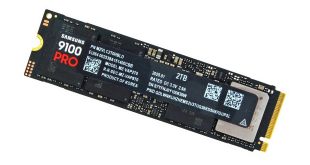Apart from the different product labels on each drive, the 30 GB and 60 GB Accelerator units are completely identical. Both features the same 2.5″ enclosure which is 9.5 mm thick.
Corsair have chosen to use black coloured metal exclusively in the construction of the SSDs casing. The black finish of the SSD should fit in aesthetically with most systems as the yellow details on the label are hardly noticeable.
Despite being made from metal, the drive casing is lightweight and it generally feels very well put together. The two halves of the casing are held together using clips which can make it quite difficult to get inside the casing.
We wouldn't recommend opening the casing anyway as it will void the warranty.
Inside the drive, we find a tiny PCB which only extends half the depth of the casing. This is secured to the bottom plate of the casing using three screws. For the 60 GB drive, we find four 8 GB Micron 29F64G08CBAAA chips on the top side of the SSD.
Turning the PCB over, we can see four further memory chips alongside the SandForce SF-2141TB1-SDC controller as the 30 GB model. The two drives feature 32 GB and 64 GB of physical memory, of which 30 GB and 60 GB is available to use. This number will be reduced further when the drive is formatted in Windows.
The slight difference in physical and usable memory can be attributed to over-provisioning which is used by the controller to extend the life of the drive.
For the 30 GB drive, there are two memory chips visible on the top side of the PCB alongside two empty spaces. These are also 8 GB Micron Branded modules and carry the same part number, 29F64G08CBAAA.
Turning over the PCB reveals two further 8 GB memory chips alongside the SandForce SF-2141TB1-SDC controller. This controller is a SATA-300 model designed to be used in low capacity SSDs such as the Accelerator models.
Setting up one of these Accelerator drives as a cache is very simple indeed. The quick start guide directs the user to Corsair's website to download the software which takes less than five minutes to install. After rebooting the system, the cache drive is fully functional.
The setup procedure is much simpler than setting up Intel's Smart Response technology although there isn't any reason why you couldn't use Intel's software rather than Corsair's with these drives.
It's worth noting that the Corsair Accelerator drives are compatible with all platforms unlike SRT which is restricted to Intel's Z68 and Z77 platforms. This means these drives are ideal to use with an AMD system.
 KitGuru KitGuru.net – Tech News | Hardware News | Hardware Reviews | IOS | Mobile | Gaming | Graphics Cards
KitGuru KitGuru.net – Tech News | Hardware News | Hardware Reviews | IOS | Mobile | Gaming | Graphics Cards










Nice idea, but the price drops have killed cache drives IMO.
I still dont have an SSD in my main system, im embarassed to say